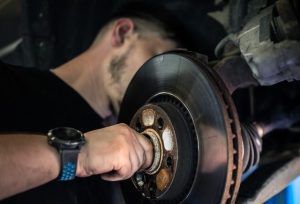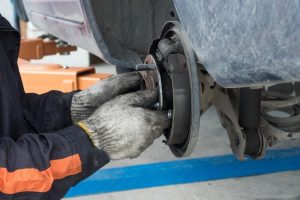Most drivers think of their vehicle’s brake system and wheel bearings as separate entities — one responsible for stopping, the other for keeping the wheels spinning smoothly. Yet, these two systems are more interconnected than many realize. A fault in one can quickly compromise the other, leading to reduced safety, poor handling, and costly repairs. Understanding the link between brake health and bearing performance is key to maintaining both reliability and efficiency on the road.
Why Brake and Bearing Systems Depend on Each Other

At the core, both systems operate within the wheel assembly, where precision and stability are essential. When braking occurs, tremendous heat, pressure, and vibration are generated — all of which directly affect the wheel hub and bearing unit.
When bearings wear out, they cause excessive wheel play, which misaligns the brake rotor and leads to uneven pad wear and poor braking response. Conversely, a dragging brake caliper or warped rotor increases friction and heat, which can overheat bearings and damage their lubrication.
This mutual dependence means that if one system fails, the other is not far behind.
Table 1: Comparison of Functions
| Component | Main Function | Impact on the Other System |
|---|---|---|
| Brake Discs & Pads | Convert motion into heat to stop the vehicle | Excess heat can overheat and degrade bearing grease |
| Wheel Bearings | Allow smooth wheel rotation with minimal friction | Worn bearings can misalign the rotor and reduce braking efficiency |
| Calipers | Apply pressure to brake pads | Sticking calipers create constant friction and bearing stress |
| Hub Assembly | Houses bearings and connects wheel to axle | Damaged hub increases brake rotor runout and vibration |
Signs of Brake-Bearing Interdependence Problems
It’s not always easy to tell whether a sound or vibration is coming from your brakes or your bearings. Here are symptoms that often indicate issues in both systems:
-
Grinding or humming noises increasing with speed
-
Steering wheel vibration during braking
-
Uneven brake pad wear
-
Excessive heat or burning smell after driving
-
ABS warning light or traction control issues
-
Wheel wobble or looseness
If these signs appear, a joint inspection of the brake system and wheel hub assembly should be performed immediately.
How Brake Issues Affect Bearings
Brake-related problems can quickly degrade bearing performance.
Common causes include:
-
Overheating: Continuous heavy braking or stuck calipers transfer heat to the hub, breaking down bearing grease.
-
Rotor Warping: A warped rotor creates uneven contact, causing side loads on bearings.
-
Corrosion: Brake fluid leaks or road salt can penetrate seals, leading to rust and bearing wear.
-
Imbalance: Worn brake components can cause rotor wobble, stressing bearings unevenly.
Over time, this combination leads to premature bearing failure, often accompanied by noise, vibration, or even wheel lock-up in extreme cases.
How Bearing Wear Affects Brakes
While brake heat can damage bearings, the reverse is also true.
Bearing-related brake problems include:
-
Rotor Runout: A loose or worn bearing can tilt the rotor slightly, causing uneven brake pad contact.
-
Pulsating Pedal: When rotor wobble occurs, drivers may feel vibration in the brake pedal.
-
ABS Malfunction: Modern bearings often house ABS sensors. A failing bearing may send false speed signals to the ECU.
-
Pad Glazing: Uneven rotor movement causes brake pads to overheat and glaze, reducing stopping power.
Table 2: Common Problems and Solutions
| Issue | Likely Cause | Recommended Action |
|---|---|---|
| Grinding noise while braking | Worn bearings or pads | Inspect hub and brake components |
| Uneven pad wear | Rotor misalignment from bad bearings | Replace bearings and resurface rotors |
| ABS light on dashboard | Faulty bearing speed sensor | Replace wheel hub unit |
| Vibration under braking | Warped rotor or loose bearing | Replace rotor and hub assembly |
| Wheel wobble | Bearing play or hub damage | Replace complete hub kit |
Preventive Maintenance Tips
To extend the lifespan of both systems, proactive care is essential. Follow these maintenance recommendations:
-
Inspect wheel bearings every 40,000–60,000 km for play or noise.
-
Check brake components (pads, discs, calipers) at every service interval.
-
Avoid aggressive driving and heavy braking to limit heat buildup.
-
Replace seals and gaskets promptly to prevent moisture ingress.
-
Use quality replacement parts — poor materials can fail prematurely.
-
Clean and lubricate contact surfaces when replacing components.
-
Always replace hub and bearing assemblies in pairs on the same axle for balanced performance.
For reliable and durable replacements, you can Buy Wheel Hub & Bearings online to ensure OEM-grade fitment and optimal performance.
Cost Overview: Brake vs. Bearing Repairs
| Component | Typical Replacement Interval | Average Cost Range (€) |
|---|---|---|
| Brake Pads | 30,000–50,000 km | 100–250 per axle |
| Brake Discs | 50,000–80,000 km | 150–300 per axle |
| Wheel Bearings | 80,000–120,000 km | 200–600 per hub |
| Wheel Hub Assembly | 80,000–150,000 km | 300–800 with labor |
| ABS Sensor Integrated Hub | 100,000+ km | 400–900 |
Tip: When replacing bearings, it’s wise to inspect and, if necessary, replace adjacent brake parts to prevent repeated labor costs later.
DIY or Professional Replacement?

| Option | Pros | Cons |
|---|---|---|
| DIY | Lower cost, personal satisfaction | Requires tools, precision, and experience |
| Professional Service | Proper diagnostics, warranty, correct installation | Higher labor costs |
If you’re not confident in handling high-precision components, professional replacement is the safer option. Incorrect torque settings or contamination during assembly can lead to early failure.
Final Thoughts
The relationship between the brake system and wheel bearings is a perfect example of how interconnected vehicle systems truly are. Ignoring a small vibration or noise may start as a minor annoyance but can escalate into a safety hazard and costly repair if left unchecked.
Regular inspections, timely replacements, and quality parts are the foundation of reliable performance. Whether you’re dealing with routine maintenance or a full hub replacement, ensure every part works in harmony.
For trusted, high-quality components that ensure both safety and longevity, explore Buy Wheel Hub & Bearings online — your reliable source for professional-grade wheel hub and bearing assemblies.